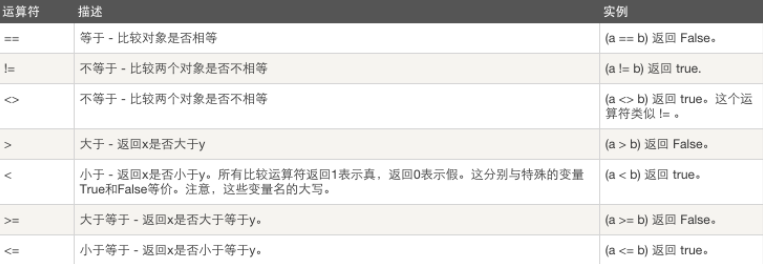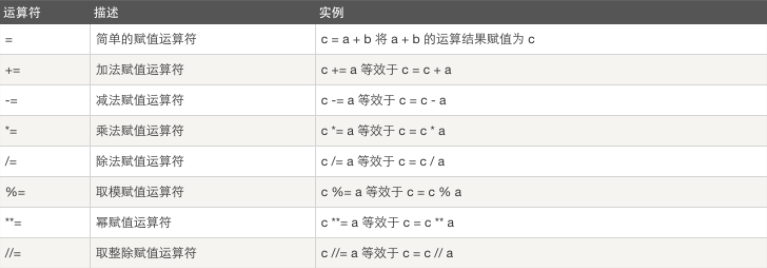机器语言:直接使用二进制指令去编写程序,直接操作硬件,必须考虑硬件细节
汇编语言:用英文标签取代二进制指令去编写程序,直接操作硬件,必须考虑硬件细节
高级语言:用人类能理解的表达方式去编写程序,通过操作系统间接地操作硬件,无需考虑硬件细节
编译型:类似于谷歌翻译
解释型:类似与同声传译
执行效率:机器语言>汇编语言>编译型>解释型
开发效率:解释型>编译型>汇编语言>机器语言
跨平台性:解释型>all
二 安装python解释器,实现多版本共存
设置环境变量PATH
三 执行python程序的两种方式:
1.交互式环境:用来调试环境,无法永久保存代码
优点:输入一行代码立刻返回结果
缺点:无法永久保存代码
2.把程序以文件的方式将代码永久保存了下。执行方式如下:python3 D:\test.txt
注意:运行python2程序是不考虑文件后缀名的,但约定俗成,应该将python程序的后缀名命名为.py
四、运行python程序的三个步骤(**)重要
1、先启动python解释器
2、将python程序当中普通的文本文件读入内存(此时没有语法的概念)
3、python解释器解释执行刚刚读入内存的代码,开始识别python的语法
五.变量
print('hello') # 这一个打印功能
1.什么是变量
量:记录某种现实世界中事物的某种状态
变:事物的某种状态是可以发生变化的
2.为何要用变量
为了让计算机能够像人一样记录下来事物的某种状态
3.如何用变量
原则:先定义,后引用
先定义
age=18
定义变量的三大组成部分:
1.1 变量名:是访问到值的唯一方式
1.2 =:将变量值的内存地址绑定给变量名
1.3 变量的值:用来表示事物的某种状态,是我们要存储的数据
2.后引用
print(age)
六.与用户交互
1.接收用户输入
name=input("请输入您的账号:") #name="egon"
print(name)
2.格式化输出
name = input("请输入您的账号:") # name="egon"
age = input("请输入您的年龄:") # age="18"
print(name,age)
print('my name is %s my age is %s' % (name,age))
1.Cpython解释器的垃圾回收机制
什么是垃圾:当一个值身上没有人绑定任何变量名(该值的引用计数=0)时,该值就是一个垃圾
01.引用计数增加
age=18 # 18的引用计数等于1
x=age # 18的引用计数等于2
print(age)
print(x)
02.引用计数减少
age=19 #18的引用计数等于1
print(age)
del x #18的引用计数等于0
2.变量值的三个特征:
id: 反映的是内存地址
type:数据类型
value: 值
age=18
print(id(age)) -> 140718207260224
print(type(age)) -> <class 'int'>
print(age) -> 18
总结:
2.1. id相同,值一定相同
2.2. 值相同,id可以不同
x='name:egon age:18'
y='name:egon age:18'
id(x)
2847698422856
id(y)
er2847698422928
x=11111111111111111111111111231231231231222222222222
y=11111111111111111111111111231231231231222222222222
print(id(x))
print(id(y))
3.is 与 ==
==:值是否相等
is:id是否相等
4.可变类型与不可变类型
可变类型: 值改变,id不变,证明就是在改变原值
不可变类型:值改变,id也变,证明根本不是在改变原值,是创建了新值,原值就是不可变类型
x=10
print(id(x))
x=11
print(id(x))
l=['a','b','c']
print(id(l))
l[0]='A'
print(id(l))
print(l)
八.python2中与用户交互
1.在python3中只有一个input:
特点:会用户输入的任意内容都存成str类型
x=input('>>>: ') #x='123123123'
print(type(x))
salary=input('>>: ') #salary='3000'
salary=int(salary)
print(salary * 12)
2.在python3中只有一个raw_input,与python3的input一模一样
x=raw_input('>>>: ')
要求用户必须输入一个明确的类型,输入什么类型就存成什么类型
x=input('>>>: ')
九.数据类型的基本使用
1: 数字类型
01.整型int
作用:用来记录年龄、等级、各种号码状态
定义:
age=10 #age=int(10)
print(type(age))
使用:
print(age + 1)
print(age > 3)
02.浮点型float
作用:用来记录身高、体重、工资状态
定义:
salary=3.1 #salary=float(3.1)
print(type(salary))
使用:
print(3.1 + 2.3)
print(3.1 > 2.3)
print(3.1 > 2)
print(3.1 + 2)
2:字符串类型str
作用:用来记录描述性质状态,比如名字、性别
定义:在单引号('')、双引号("")、三引号内(''' ''',""" """),包含一系列的字符
x='abc' # x=str('abc')
print(type(x))
y="abc"6
z="""
abc
xxxx
"""
print(type(x))
print(type(y))
print(type(z))
msg='my name is "egon"'
使用:
print('abc'+'def') # 仅限于str类型直接相加
print('abc'*10) # *的只能是数字
x='abcdef'
y='z'
print(x > y)
print('a' > 'Z' )
3:列表类型list
作用:用来记录多个值,用索引对应值,索引反映是位置# 定义:在[]内用逗号分隔开多个任意类型的值
l=[1,3.1,'xxx',['a','b','c']] #l=list(...)
print(type(l))
使用
print(l[0])
print(l[2])
print(l3)
students_info=[
['egon',18,['play',]],
['alex',18,['play','sleep']]
]
print(students_info1[0])
4:字典类型dict
作用:用来记录多个值,用key对应value,其中key对value有描述性的功能
定义:在{}内,用逗号分割开多元素,每一个元素都是key:value的形式,其中value可以是任意类型,而key通常应该是str类型
d={'x':1,'y':3.1,'z':['a','b'],'m':{'aaa':1111}} #d=dict(...)
print(type(d))
使用:
print(d['x'])
print(d'm')
print(d'z')
列表的方式
name age gender compay_info
emp_info=['egon',18,'male',['Oldboy','SH',200]]
print(emp_info[1])
print(emp_info[3][2])
字典的方式
emp_info={'name':'egon','age':18,"gender":'male','company_info':['Oldboy','SH',200]}
print(emp_info['age'])
print(emp_info['company_info'][0])
names=['egon','alex','kevin']
dic={'name1':'egon','name2':'alex','name3':'kevin'}
5:布尔类型:True,Flase
print(type(True))
print(type(False))
tag1 = True
tag2 = True
print(id(tag1))
print(id(tag2))
age = 18
print(age > 18)
所有数据类型自带布尔值
布尔值为假的数据类型:0,None,空
print(bool([]))
print(bool(''))
print(bool(None))
6: None
print(type(None))
十.基本运算符
01. 比较运算符

print(10 != 11)
了解
x=None
print(x == None)
print(x is None)
l1=['abc',1,['a','b','c']]
l2=['z','aa',]
print(l2 > l1)
02. 逻辑运算符

and:连接左右两个条件,只有两个条件同时成立时and运算的结果为True
print(10 > 9 and 3 > 2 and 'egon' == 'egon' and True)
or:连接左右两个条件,两个条件成立任意一个or运算的结果就为True
print(False or False or True or False or 3 > 10)
res=(True or (False and True)) or ((False or True) and False)
res=(True or False) or (True and False)
res=True or False
print(res)
not:取反
print(not 10 > 3)
x=None
print(not x is None)
print(x is not None)
age1=18
age2=19
print(age2 is not age1)
name_bk='egon'
pwd_bak='123'
name=input('please input your name: ')
pwd=input('please input your password: ')
if name == name_bk and pwd == pwd_bak:
print('login successfull')
else:
print('user name or password error')
03.算术运算
04.赋值运算

增量赋值
age=18
age+=1#age=age + 1
print(age)
age=18
age/=3 #age=age/3
print(type(age))
age**=2 #age=age**2
交叉赋值
x=10
y=20
temp=x
x=y
y=temp
x,y=y,x
print(x,y)
链式赋值
x=10
y=x
z=y
x=y=z=10
print(id(x))
print(id(y))
print(id(z))
解压赋值
l=[1.2,2.2,3.3,4.4,5.5]
a=l[0]
b=l[1]
c=l[2]
d=l[3]
e=l[4]
a,b,c,d,e=l
l=[1.2,2.2,3.3,4.4,5.5]
a,b,*_=l
print(a,b)
a,*_,b=l
print(a,b)
*_,a,b=l
print(a,b)
python程序中变量名使用大写字母来表示的常量,比如AGE_OF_OLDBOY=73
十二.流程控制之if判断
语法1:
'''
if 条件:
代码1
代码2
代码3
...
'''
示例:
age_of_bk=30
print('start.....')
inp_age=input('>>>: ') #inp_age='18'
inp_age=int(inp_age)
if inp_age == age_of_bk:
print('猜对了')
print('end.....')
语法2:
'''
if 条件:
代码1
代码2
代码3
...
else:
代码1
代码2
代码3
...
'''
示例:
age=38
gender='male'
is_beautiful=True
if age >= 18 and age <= 25 and gender == 'female' and is_beautiful:
print('开始表白。。。。')
else:
print('阿姨好')
语法3:
'''
if 条件1:
代码1
代码2
代码3
...
elif 条件2:
代码1
代码2
代码3
...
elif 条件3:
代码1
代码2
代码3
...
elif 条件4:
代码1
代码2
代码3
...
else:
代码1
代码2
代码3
...
'''
示例:
'''
如果:
成绩>=90,那么:优秀
如果成绩>=80且<90,那么:良好
如果成绩>=70且<80,那么:普通
其他情况:很差
'''
score=input('your score>>: ')
score=int(score)
if score >=90:
print('优秀')
elif score >=80:
print('良好')
elif score >=70:
print('普通')
else:
print('很差')
语法4:
'''
if 条件1:
if 条件2:
代码1
代码2
代码3
...
代码2
代码3
'''
示例:
age=18
gender='female'
is_beautiful=True
is_successful=True
if age >= 18 and age <= 25 and gender == 'female' and is_beautiful:
print('开始表白。。。。')
if is_successful:
print('在一起')
else:
print('我逗你玩呢。。。')
else:
print('阿姨好')
十三.流程控制之while循环
1.while循环:条件循环
基本语法
while 条件:
代码1
代码2
代码3
...
示范
name_of_bk='egon'
pwd_of_bk='123'
tag=True
while tag:
inp_name=input('your name>>: ')
inp_pwd=input('your password>>: ')
if inp_name == name_of_bk and inp_pwd == pwd_of_bk:
print('login successful')
tag=False
else:
print('username or password error')
2.while+break:break代表结束本层循环
name_of_bk='egon'
pwd_of_bk='123'
while True:
inp_name=input('your name>>: ')
inp_pwd=input('your password>>: ')
if inp_name == name_of_bk and inp_pwd == pwd_of_bk:
print('login successful')
break
else:
print('username or password error')
3.while + continue: continue代表结束本次循环,直接进入下一次
示范:
count=1
while count < 6:
if count == 3:
count+=1
continue
print(count)
count+=1
4.while + else
count=0
while count <= 10:
print(count)
count+=1
else:
print("else的子代块只有在while循环没有被break打断的情况下才会执行")
5.死循环
count=0
while True:#True 本身就是真呀
print("你是风儿我是沙,缠缠绵绵走天涯...",count)
count +=1
6.输错三次退出
name_of_bk='egon'
pwd_of_bk='123'
count=0
tag=True
while tag:
if count == 3:
print('输错的次数过多。。。')
break
inp_name=input('your name>>: ')
inp_pwd=input('your password>>: ')
if inp_name == name_of_bk and inp_pwd == pwd_of_bk:z
print('login successful')
while tag:
print("""
0 退出
1 购物
2 支付
3 查看购物
""")
cmd=input('>>>: ')
if cmd == '0':
tag=False
continue
if cmd == '1':
print('购物。。。。。。。')
elif cmd == '2':
print('支付。。。。。')
elif cmd == '3':
print('查看购物车')
else:
print('输入错误的指令')
else:
print('username or password error')
count+=1 #count=3 输错3次
十四.for循环
用while循环:
l=['a','b','c']
print(len(l))
i=0
while i<len(l):
print(l[i])
i+=1
用for循环:
l=['a','b','c']
for item in l: #item='a'
print(item)
dic={'x':111,'y':222,'z':333}
for k in dic: #k='x'
print(k,dic[k])
1.while循环 vs for循环
01.
while循环:称之为条件循环,循环的次数取决于条件何时为False.
for循环:称之为迭代式循环,循环的次数取决于数据的包含的元素的个数.
02.
for循环专门用来取值,在循环取值方面比while循环要强大,以后但凡.
遇到循环取值的场景,就应该用for循环
0 1 2
l=['a','b','c']
for i in range(3):
print(i,l[i])
2.for+continue
names=['egon','kevin','alex','hulaoshi']
for name in names:
if name == 'alex':continue
print(name)
3.for+break
names=['egon','kevin','alex','hulaoshi']
for name in names:
if name == 'alex':break
print(name)
4.for+else
names=['egon','kevin','alex','hulaoshi']
for name in names:
if name == 'alex':break
print(name)
else:
print('=====>')
5.for循环嵌套
for i in range(3):
for j in range(2):
print(i,j)
'''
外层循环第一次:i=0
内层循环
0,0
0,1
外层循环第二次:i=1
内层循环
1,0
1,1
外层循环第三次: i=2
内层循环
2,0
2,1
'''
